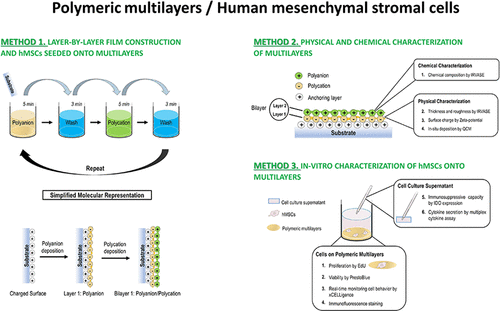当前位置:
X-MOL 学术
›
ACS Biomater. Sci. Eng.
›
论文详情
Our official English website, www.x-mol.net, welcomes your
feedback! (Note: you will need to create a separate account there.)
Methods for the Assembly and Characterization of Polyelectrolyte Multilayers as Microenvironments to Modulate Human Mesenchymal Stromal Cell Response
ACS Biomaterials Science & Engineering ( IF 5.4 ) Pub Date : 2020-11-19 , DOI: 10.1021/acsbiomaterials.0c01397 David A. Castilla-Casadiego 1 , Hemanta Timsina 1 , Mahsa Haseli 1 , Luis Pinzon-Herrera 1 , Yu-Hsuan Chiao 1 , S. Ranil Wickramasinghe 1 , Jorge Almodovar 1
ACS Biomaterials Science & Engineering ( IF 5.4 ) Pub Date : 2020-11-19 , DOI: 10.1021/acsbiomaterials.0c01397 David A. Castilla-Casadiego 1 , Hemanta Timsina 1 , Mahsa Haseli 1 , Luis Pinzon-Herrera 1 , Yu-Hsuan Chiao 1 , S. Ranil Wickramasinghe 1 , Jorge Almodovar 1
Affiliation

|
Thin films are of interest in materials design because they allow for the modification of surface properties of materials while the bulk properties of the material are largely unaffected. In this work, we outline methods for the assembly of thin films using a technique known as layer-by-layer (LbL). Furthermore, their interactions with human mesenchymal stromal cells (hMSCs) are discussed. hMSCs are a subject of growing interest because of their potential to treat or cure diseases, given their immunosuppressive properties, multipotent differentiation capabilities, and tissue regeneration capabilities. Numerous improvements and modifications have been suggested for the harvesting, treatment, and culture of hMSCs prior to their administration in human subjects. Here, we discuss methods to assess the interactions of hMSCs with thin LbL-assembled films of heparin and collagen. Three different methods are discussed. The first details the preparation of heparin/collagen multilayers on different surfaces and the seeding of cells on these multilayers. The second method details the characterization of multilayers, including techniques to assess the thickness, roughness, and surface charge of the multilayers, as well as in situ deposition of multilayers. The third method details the analysis of cell interactions with the multilayers, including techniques to assess proliferation, viability, real-time monitoring of hMSC behavior, analysis of hMSC-adhesive proteins on the multilayers, immunomodulatory factor expression of hMSCs, and cytokine expression on heparin/collagen multilayers. We propose that the methods described in this work will assist in the design and characterization of LbL-assembled thin films and the analysis of hMSCs cultured on these thin films.
中文翻译:

组装和表征聚电解质多层作为微环境来调节人间质基质细胞反应的方法
薄膜在材料设计中是令人关注的,因为它们允许修改材料的表面特性,而材料的整体特性在很大程度上不受影响。在这项工作中,我们概述了使用称为逐层(LbL)的技术组装薄膜的方法。此外,讨论了它们与人间充质基质细胞(hMSCs)的相互作用。hMSC由于具有免疫抑制特性,多能分化能力和组织再生能力,因此具有治疗或治愈疾病的潜力,因此受到越来越多的关注。已经建议在将hMSCs施用给人类受试者之前对其进行收获,治疗和培养进行许多改进和修饰。这里,我们讨论了评估hMSC与肝素和胶原蛋白的LbL组装薄膜相互作用的方法。讨论了三种不同的方法。第一部分详细介绍了在不同表面上制备肝素/胶原蛋白的多层膜以及在这些多层膜上植入细胞的方法。第二种方法详细介绍了多层的特征,包括评估多层的厚度,粗糙度和表面电荷以及多层沉积的技术。第三种方法详细分析了细胞与多层的相互作用,包括评估增殖,存活力,hMSC行为的实时监测,多层上的hMSC粘附蛋白的分析,hMSC的免疫调节因子表达以及肝素上的细胞因子表达的技术。 /胶原蛋白多层。
更新日期:2020-12-14
中文翻译:

组装和表征聚电解质多层作为微环境来调节人间质基质细胞反应的方法
薄膜在材料设计中是令人关注的,因为它们允许修改材料的表面特性,而材料的整体特性在很大程度上不受影响。在这项工作中,我们概述了使用称为逐层(LbL)的技术组装薄膜的方法。此外,讨论了它们与人间充质基质细胞(hMSCs)的相互作用。hMSC由于具有免疫抑制特性,多能分化能力和组织再生能力,因此具有治疗或治愈疾病的潜力,因此受到越来越多的关注。已经建议在将hMSCs施用给人类受试者之前对其进行收获,治疗和培养进行许多改进和修饰。这里,我们讨论了评估hMSC与肝素和胶原蛋白的LbL组装薄膜相互作用的方法。讨论了三种不同的方法。第一部分详细介绍了在不同表面上制备肝素/胶原蛋白的多层膜以及在这些多层膜上植入细胞的方法。第二种方法详细介绍了多层的特征,包括评估多层的厚度,粗糙度和表面电荷以及多层沉积的技术。第三种方法详细分析了细胞与多层的相互作用,包括评估增殖,存活力,hMSC行为的实时监测,多层上的hMSC粘附蛋白的分析,hMSC的免疫调节因子表达以及肝素上的细胞因子表达的技术。 /胶原蛋白多层。











































 京公网安备 11010802027423号
京公网安备 11010802027423号